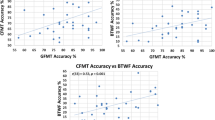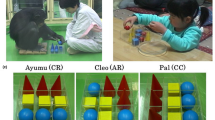Summary
The human face provides important cues for recognition of both individuals and emotions. A card-sorting test was devised for assessing which aspects of a face are attended to primarily. The subjects were 21 5-year-old children and 18 psychology students. The task required a choice between (a) person identity and an irrelevant aspect (hairstyle); (b) person identity and facial expression (emotions); and (c) as a control condition, complex visual stimuli without social meaning (form and colour). No group differences emerged with the non-social stimuli, ruling out differences between children and adults in general sorting strategies. The two groups processed non-emotional facial stimuli differently, with the children showing “mixed” sorting behaviour, and the students usually making choices based on person identity. This can be explained by different processing strategies. However, when person identity and facial expressions were the competing dimensions in the card-sorting task, both groups showed a preference for the facial expression. It is argued that this reflects the great importance of emotional signals for both children and adults. The relevance of this finding for disturbed development is discussed.
Similar content being viewed by others
References
Bahrick HP, Bahrick PO, Wittlinger RP (1975) Fifty years of memory for names and faces: a cross-sectional approach. J Exp Psychol Gen 104:54–75
Bettelheim B (1967) The empty fortress. Free Press, New York
Bühler C, Hetzer H (1928) Das erste Verständnis für Ausdruck im ersten Lebensjahr. Z Psychol 107:50–61
Bullock M, Russel JA (1984) Preschool children's interpretation of facial expressions of emotion. Int J Behav Dev 7:193–214
Carey S (1981) The development of face perception. In: Davies G, Ellis H, Shepherd E (eds) Perceiving and remembering faces. Academic Press, London, pp 9–38
Carey S, Diamond R (1977) From piecemeal to configurational representation of faces. Science 195:312–314
Caron RF, Caron AJ, Myers RS (1982) Abstraction of invariant face expressions in infancy. Child Dev 53:1008–1015
Diamond R, Carey S (1977) Developmental changes in the representation of faces. J Exp Child Psychol 23:1–22
Ekman P, Friesen WV (1975) Unmasking the face. Prentice Hall, Englewood Cliffs, NJ
Klinnert MD, Campos JJ, Sorce JF, Emde RN, Svejda M (1983) Emotions as behaviour regulators: Social referencing in infancy. In: Plutchik R, Kellermann H (eds) Emotions in early development. Academic Press, New York, pp 57–86
Oster H (1981) Recognition of emotional expression in infancy? In: Lamb ME, Sherrod LR (eds) Infant social cognition: empirical and theoretical considerations. Erlbaum, Hillsdale, New York, pp 85–125
Papoušek H, Papoušek M (1983) Biological basis of social interactions: implications of research for an understanding of behavioural deviance. J Child Psychol Psychiatry 24:117–129
Savitsky JC, Izard CE (1970) Developmental changes in the use of emotion cues in a concept formation task. Dev Psychol 3:350–351
Suchman RG, Trabasso T (1966) Colour and form preference in young children. J Exp Child Psychol 3:177–187
Tinbergen EA, Tinbergen N (1983) Autistic children: new hope for a cure. Allen & Unwin, London
Author information
Authors and Affiliations
Additional information
This research was supported by grant no. Pl 35/19-1 from the Deutsche Forschungsgemeinschaft
Rights and permissions
About this article
Cite this article
Bormann-Kischkel, C. Face recognition in children. Eur Arch Psychiatr Neurol Sci 236, 17–20 (1986). https://doi.org/10.1007/BF00641052
Received:
Issue Date:
DOI: https://doi.org/10.1007/BF00641052




